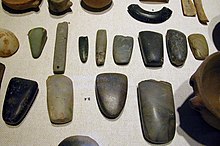Langdale axe industry
54°26′49″N 3°03′50″W / 54.447°N 3.064°W

The Langdale axe industry is the name given by archaeologists to the centre of a specialised stone tool manufacturing at Great Langdale in England's Lake District during the Neolithic period (beginning about 9500 BC in some parts of the Middle East, and later in other parts of the world).
The area has outcrops of fine-grained greenstone suitable for making polished axes which have been found distributed across Great Britain.[1] The rock is an epidotised greenstone quarried or perhaps just collected from the scree slopes in the Langdale Valley on Harrison Stickle and Pike of Stickle.
Petrographic analysis
Archaeologists are able to identify the unique nature of the Langdale stone by taking sections and examining them using microscopy. The minerals in the rock have a characteristic pattern, using a method known as petrography. They have been able to reconstruct the production methods and trade patterns employed by the axe makers. The Langdale industry produced roughly hewn (or so-called "rough-outs") axes and simple blocks as well as the highly polished final product and all were traded on throughout Britain and Ireland. Polishing the rough surfaces will have improved the mechanical strength of the axe as well as lowering friction when used against wood.
Some axes appear worn whilst others appear unused implying that they were regarded as sacred objects, as well as being used as practical tools. The shape of the polished axes suggests that they were bound in wooden staves and used for forest clearance. It has been suggested that the area itself may have had some mystical importance to its inhabitants and that axes from here were deemed significant across the British Isles[citation needed], although the hardness of the rock and its resistance to breaking made it a viable alternative to the ubiquitous flint axes widely used at the same period.
The manufacturers of the axes also built some of the first Neolithic stone circles such as that at Castlerigg.
Context

The Langdale industry was just one of many which extracted hard stone for manufacture into polished axes. The Neolithic period was a time of settlement on the land, and the development of farming on a very large scale. Clearance of the forest cover was necessary in order to plant crops and rear animals, so axes were a staple tool, not just for clearance but also for wood working timber for houses, boats and other structures. Flint was probably the most widely used, simply because it was available from numerous flint mines in the downlands, such as Grimes Graves. Cissbury and Spiennes. Offcuts from roughing-out could also be used as small knives, arrowheads and other small sharp tools.
But other stones were used, such as those from Penmaenmawr in North Wales, and similar working areas to Langdale have been found there. Many other locations for production of axes have been found across the country including Tievebulliagh in County Antrim, sites in Cornwall, Scotland and elsewhere.
The variety of rocks used in polished tools and other artefacts is evident in museum collections, not all of the sources of the rocks having been positively identified. Taking sections is necessarily destructive of part of the artefact, and thus discouraged by many museums.
See also
- Cissbury
- Grimes Graves
- Great Orme
- Flint
- Flint tool
- Penmaenmawr
- Spiennes
- Stone tool
- Tievebulliagh
- Mere
References
- ^ Rodney Castleden, Neolithic Britain: new stone age sites of England, Scotland, and Wales. Routledge, 1992, ISBN 0415058457. Retrieved 2009-10-10.
{{cite book}}: horizontal tab character in|publisher=at position 22 (help)
Bibliography
- Clare Fell, The Great Langdale stone-axe factory, Trans Cumberland and Westmorland Antiq and Arch Soc, 50, 1-13 (1950).
External links
- Megalithic portal article on Langdale axe factory
- Article on Castlerigg and the Axe industry of Langdale
- Tullie House Museum and Art Gallery link to website which contains information about the stone axes that the museum has in its collection
